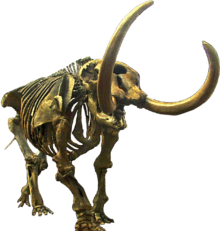Mammutidae
Mammutidae is an extinct family of proboscideans that appeared during the Oligocene epoch and survived until the start of the Holocene. The family was first described in 1922, classifying fossil specimens of the type genus Mammut (mastodons), and has since been placed in various arrangements of the order. The name "mastodon" derives from Greek, μαστός "nipple" and ὀδούς "tooth", as with the genus, referring to a characteristic that distinguishes them from allied families. The genus Zygolophodon has also been assigned to this family. Mammutids ranged very widely, with fossils found in North America, Africa, and throughout Eurasia.
| Mammutidae | |
|---|---|
 | |
| Mounted mastodon skeleton, Museum of the Earth | |
| Scientific classification | |
| Kingdom: | Animalia |
| Phylum: | Chordata |
| Class: | Mammalia |
| Order: | Proboscidea |
| Clade: | Elephantimorpha |
| Clade: | †Mammutida |
| Superfamily: | †Mammutoidea Hay, 1922[2] |
| Family: | †Mammutidae Hay, 1922 |
| Genera[3] | |
|
†Eozygodon Tassy and Pickford, 1983 | |
 | |
| The inferred range of the Mammutidae | |
| Synonyms | |
| |
Discoveries

In August 2008, miners in Romania unearthed the skeleton of a 2.5-million-year-old mastodon, believed to be one of the best preserved in Europe.[6] Ninety percent of the skeleton's bones were intact, with damage to the skull and tusks.[6] In 2009, a family in Portland, Michigan, unearthed mastodon bones while excavating a new pond on their property. It is one of around 250 mastodons found in Michigan over the past century.[7]
The first excavation to discover mastodon fossils in Elmacık village in Burdur province, Turkey, took place in 2006. As of July 2009, six mastodon fossils have been discovered in the village.[8]
In August 2011, a skeleton of a mastodon was found near Tomislavgrad in Bosnia and Herzegovina.[9] In November 2011, a mastodon skeleton was unearthed in Daytona Beach, Florida, during construction of a retention pond.[10] The find is being studied by the Daytona Beach Museum of Arts and Sciences.
References
- "Mammutidae in the Paleobiology Database". Fossilworks. Retrieved 2019-08-10.
- Hay, Oliver Perry (1922). "Further observations on some extinct elephants" (PDF). Proceedings of the Biological Society of Washington. 35: 97–101. Retrieved 2019-10-07.
- Shoshani, Jeheskel; Pascal Tassy (2005). "Advances in proboscidean taxonomy & classification, anatomy & physiology, and ecology & behavior". Quaternary International. 126-128: 5–20. Bibcode:2005QuInt.126....5S. doi:10.1016/j.quaint.2004.04.011.
- Wang, S.-Q.; Zhang, X.-X.; Li, C.-X. (2020). "Reappraisal of Serridentinus gobiensis Osborn & Granger and Miomastodon tongxinensis Chen: the validity of Miomastodon" (PDF). Vertebrata PalAsiatica. doi:10.19615/j.cnki.1000-3118.200310. Retrieved 2020-03-15.
- Dimila Mothé, Leonardo S. Avilla, Desi Zhao, Guangpu Xie and Boyang Sun (2016). "A new Mammutidae (Proboscidea, Mammalia) from the Late Miocene of Gansu Province, China". Anais da Academia Brasileira de Ciências. 88 (1): 65–74. doi:10.1590/0001-3765201520150261. PMID 26839998.CS1 maint: uses authors parameter (link)
- 2.5 million-year-old mastodon unearthed in Romania, USA Today, 2008-08-08, Retrieved on 11 August 2008
- "Michigan Family Finds Prehistoric Bones - Mastodon Bones To Be Given To University Of Michigan". The Associated Press. 2 July 2009. Archived from the original on 5 July 2009. Retrieved 3 July 2009.
- "Mastodon Fossils Discovered In Burdur/Turkey". Yerbilimleri. July 17, 2009. Archived from the original on 2009-07-20. Retrieved 17 July 2009.
- U Tomislavgradu otkriven kostur pretka slona, Večernji list, 2011-08-18. Retrieved 2011-08-26 (in Croatian)
- "More mastodon pieces turning up at Daytona site". 2011-11-30. Archived from the original on 2018-11-08. Retrieved 2018-11-08.
| Wikimedia Commons has media related to Mammutidae. |
| Wikispecies has information related to Mammutidae |